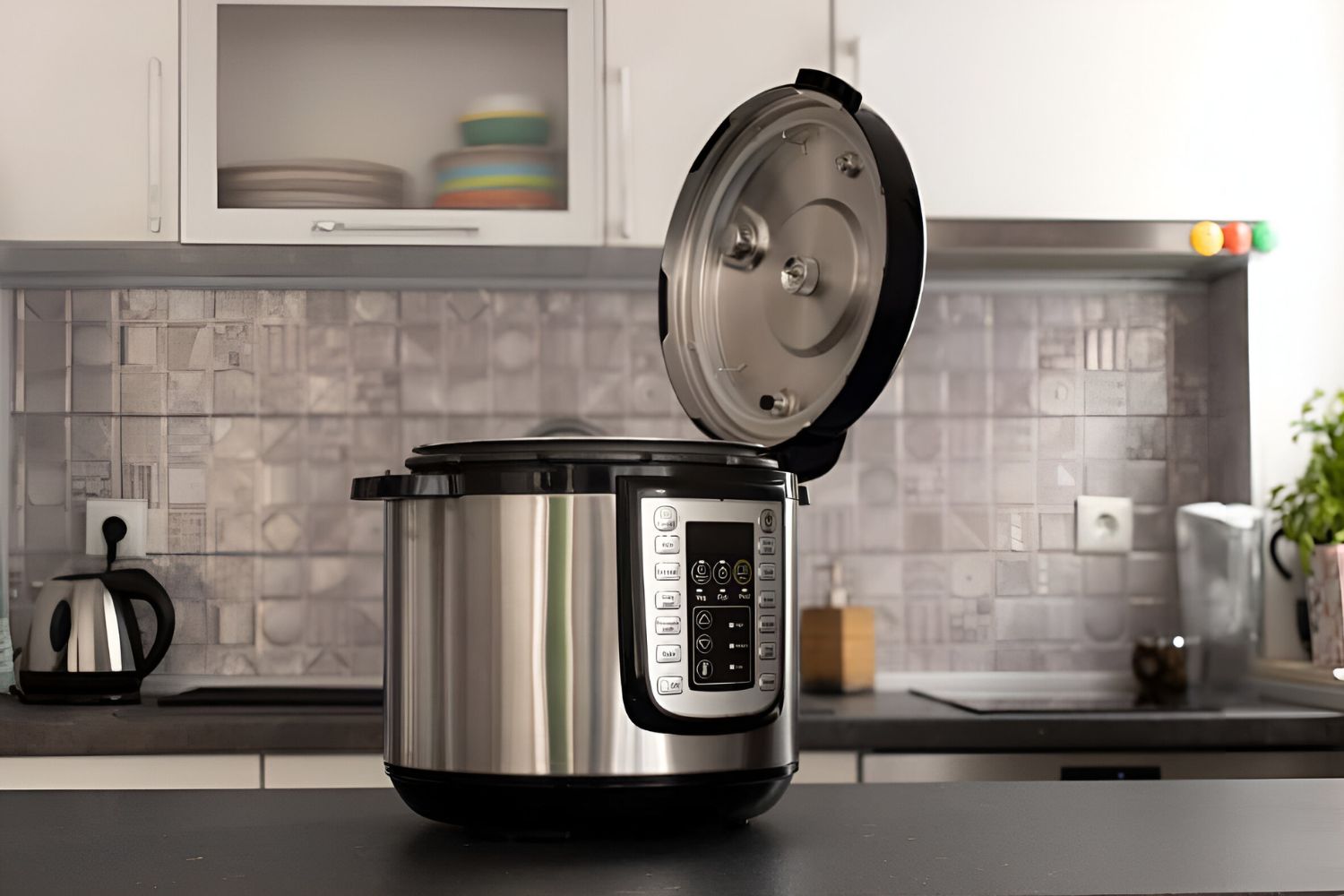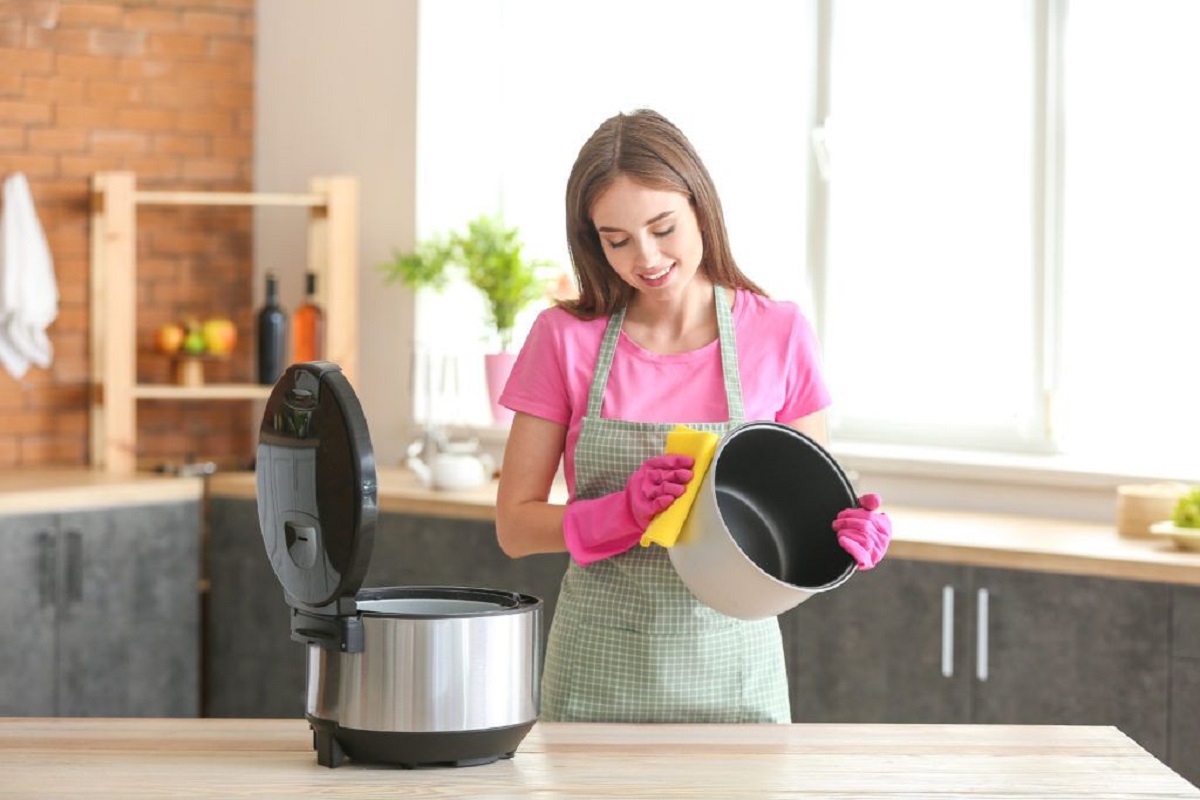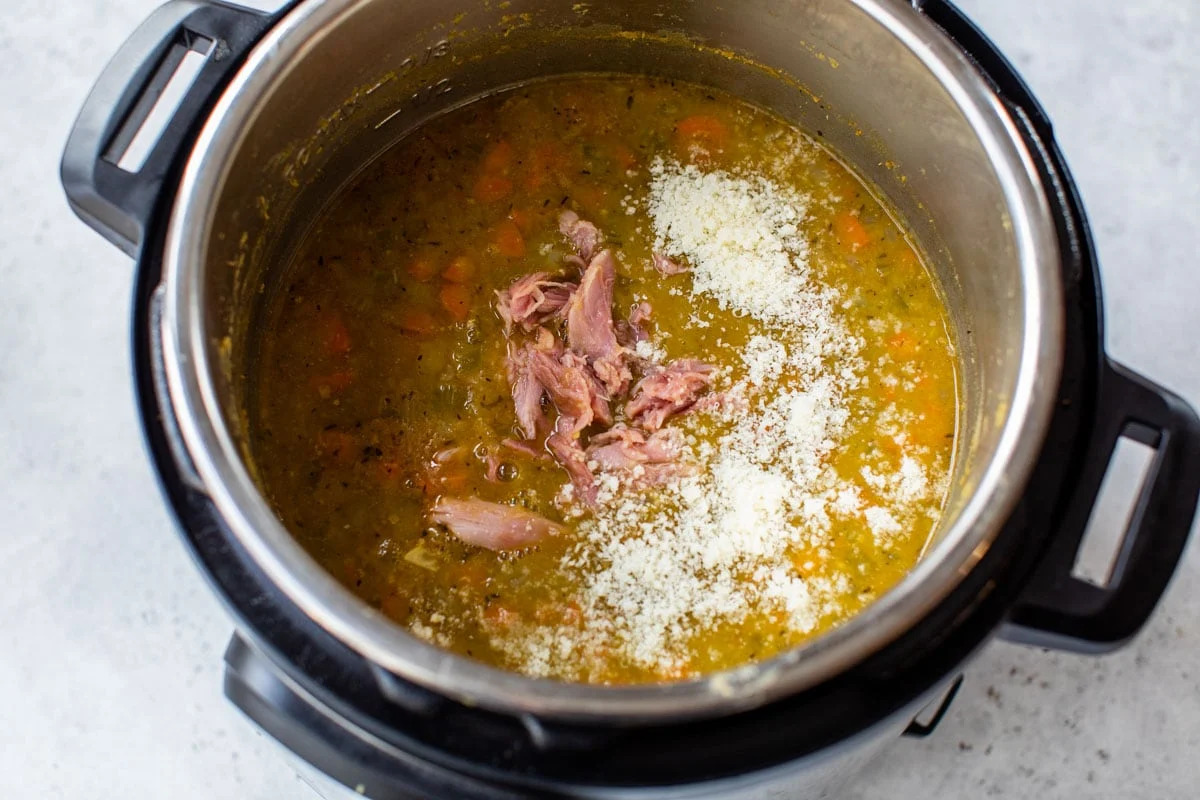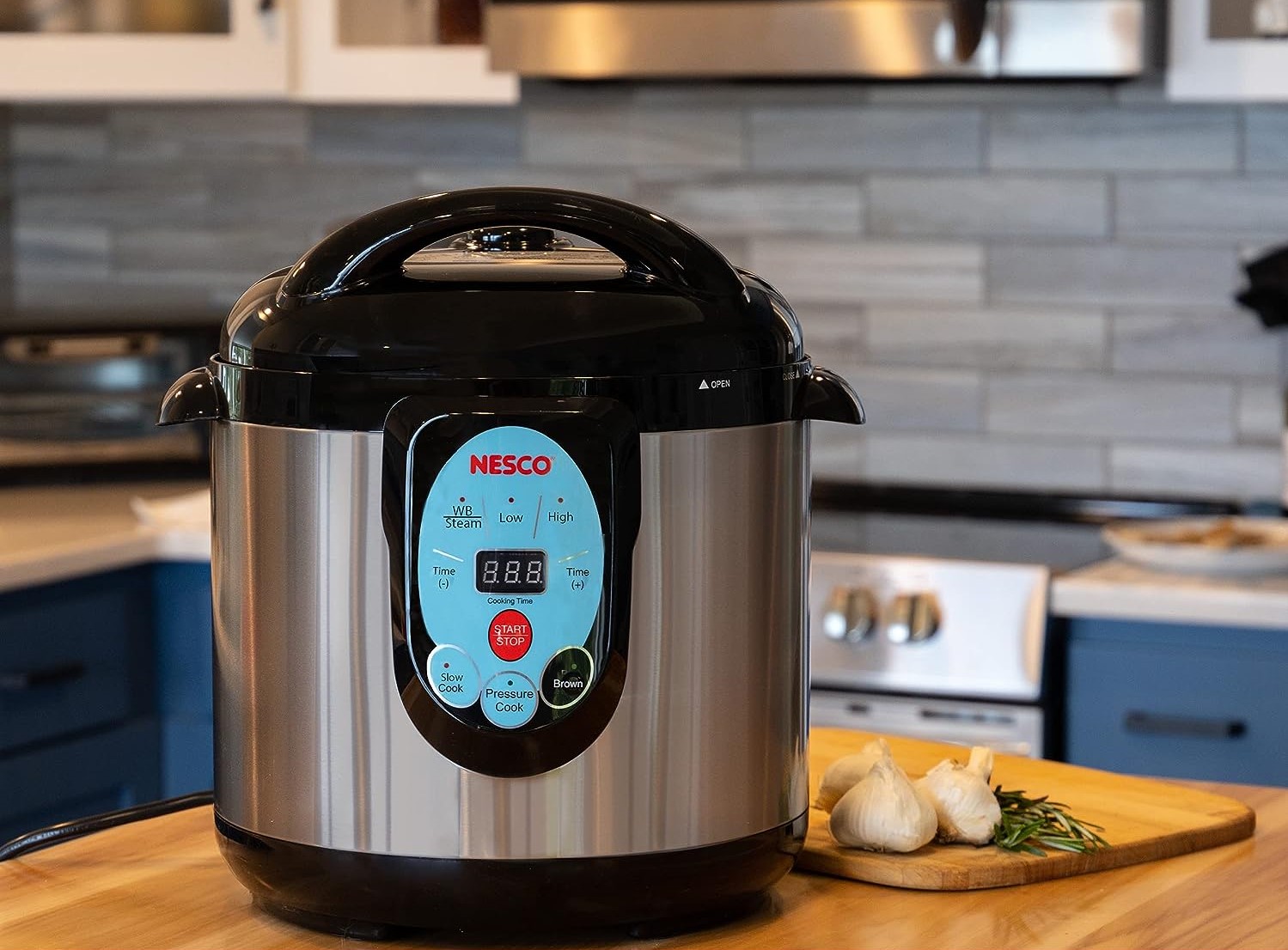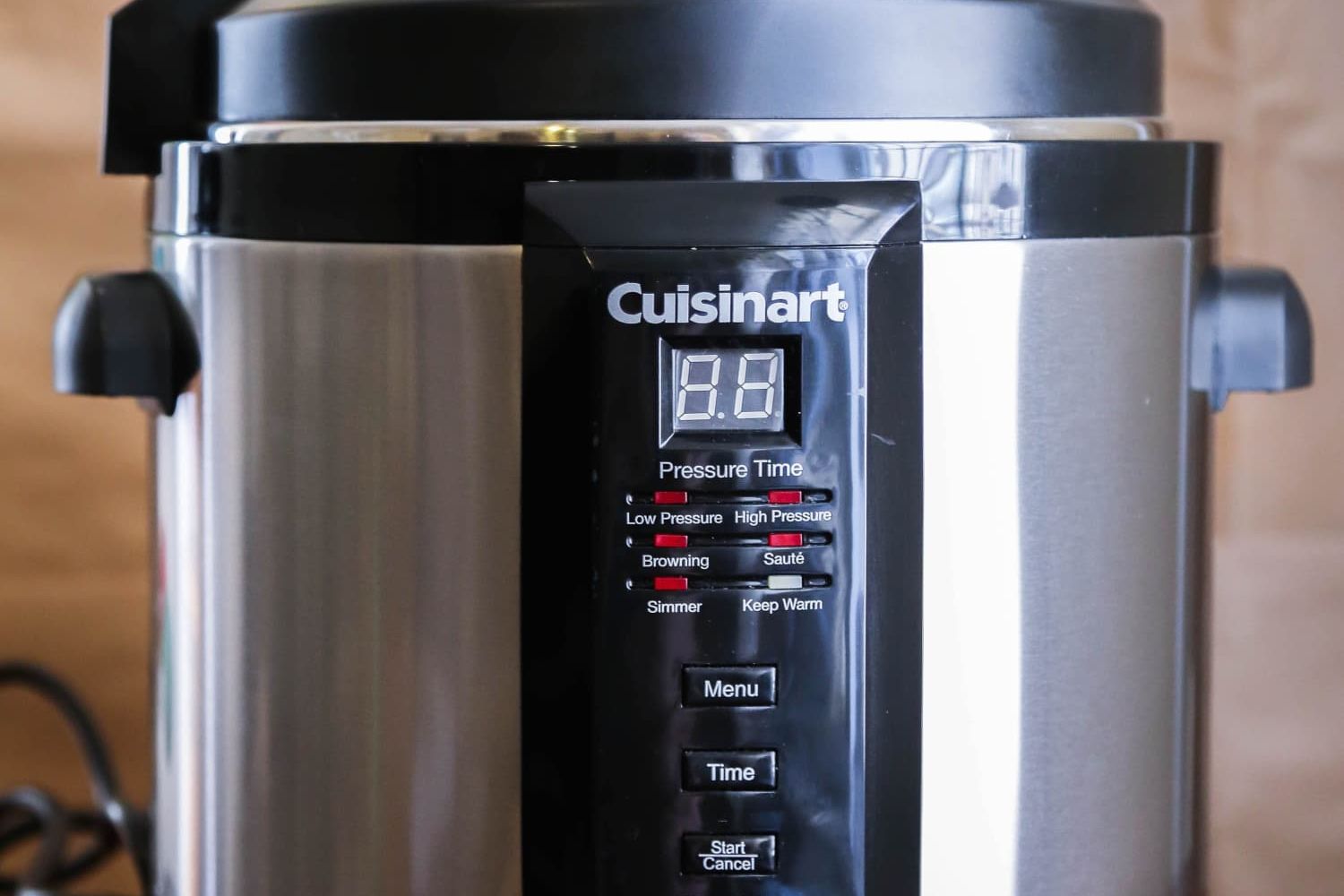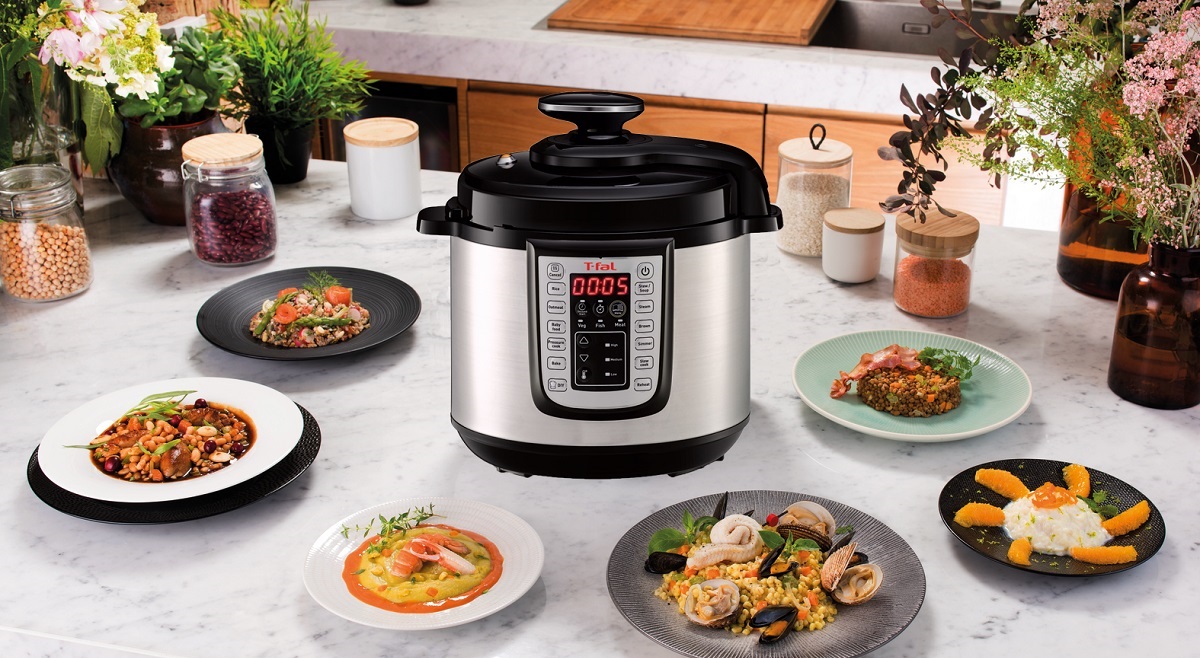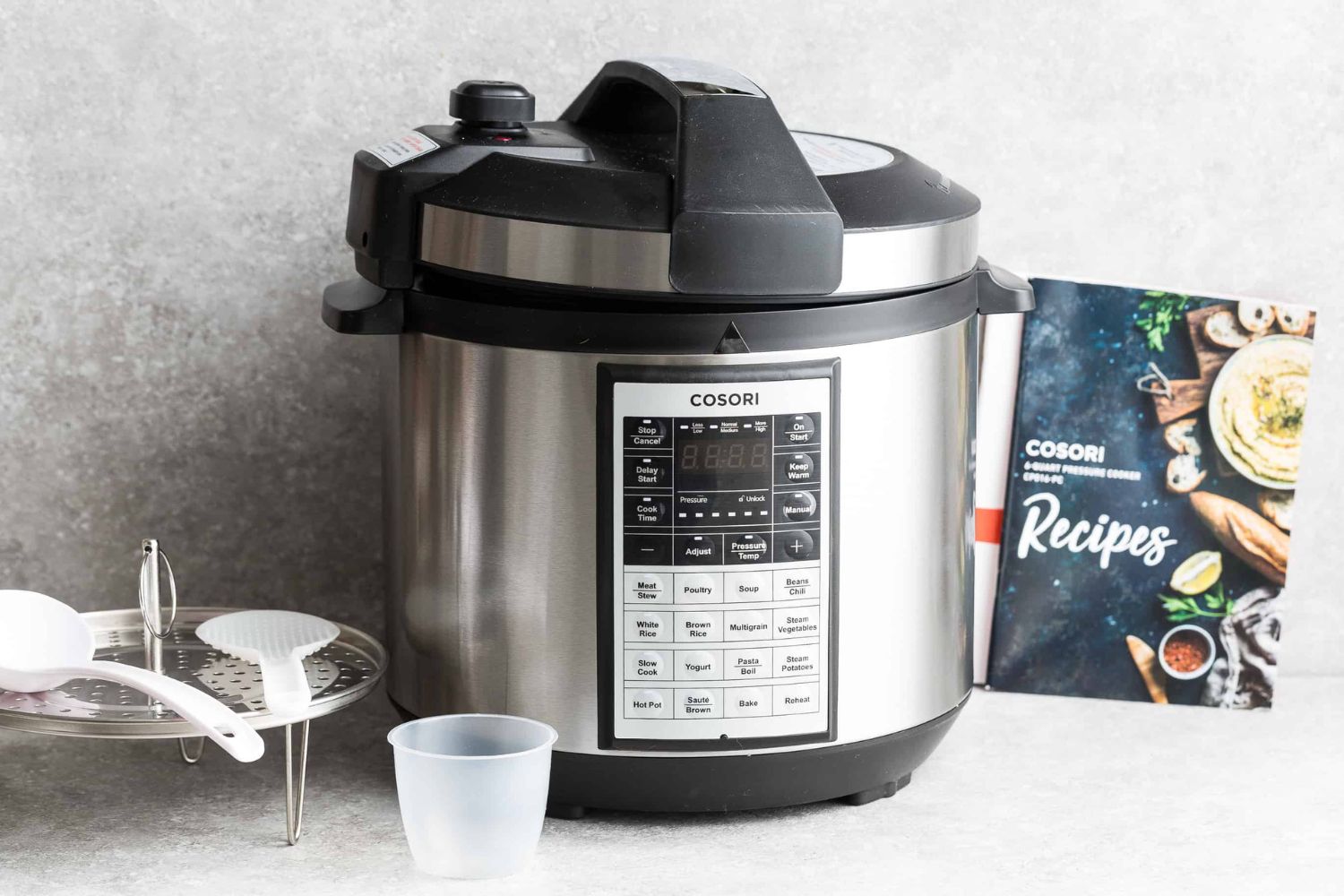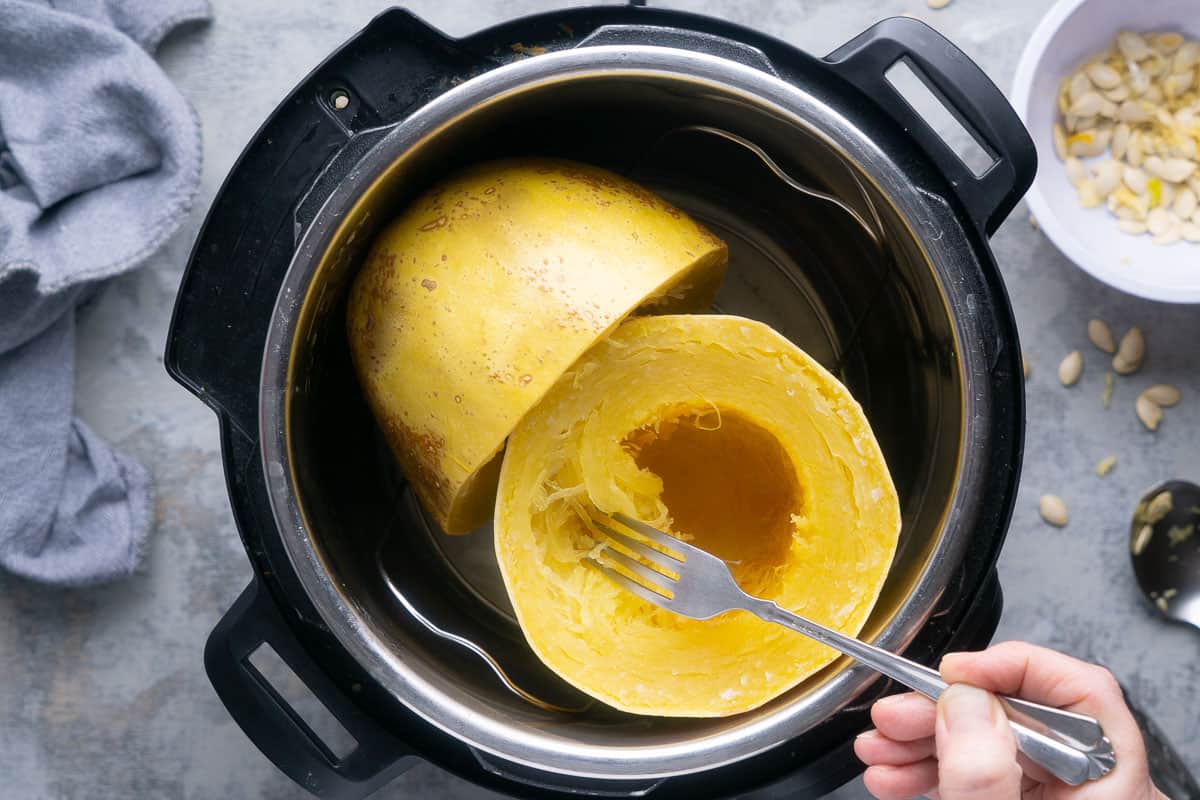Introduction
Welcome to our troubleshooting guide on why your electric pressure cooker won’t start. Electric pressure cookers are versatile kitchen appliances that make cooking convenient and efficient. However, there may be instances when you encounter issues with your pressure cooker not starting, leaving you frustrated and unable to prepare your desired meals.
There can be various reasons behind an electric pressure cooker not starting, ranging from simple power issues to more complex malfunctions within the appliance itself. Understanding these potential issues and learning how to troubleshoot them can help you get your pressure cooker back up and running in no time.
In this article, we will explore the common reasons why an electric pressure cooker may not start and provide you with troubleshooting steps to resolve these issues. By following these steps, you can save time and avoid unnecessary stress in the kitchen.
Before we dive into the specific troubleshooting steps, it’s important to note that safety should always be a top priority when dealing with any kitchen appliance. Make sure to read and follow the manufacturer’s instructions and guidelines to prevent accidents or damages.
So, let’s get started and discover why your electric pressure cooker is refusing to start and how you can fix it!
Common Reasons for Electric Pressure Cooker Not Starting
There could be several reasons why your electric pressure cooker is not starting. Let’s delve into some of the most common causes:
- Power Issue: Ensure that the pressure cooker is properly connected to a power source. Check if the power switch is turned on and if there is electricity in the outlet. If the cooker still doesn’t start, move on to the next troubleshooting step.
- Faulty Outlet or Power Source: Sometimes, the issue might lie with the power outlet or source itself. Try plugging another appliance into the same outlet to check if it is working. If not, there might be a problem with the power source, and you should consult an electrician.
- Defective Power Cord: Inspect the power cord for any frays, cuts, or damage. A damaged power cord can prevent the cooker from starting. If you notice any issues, replace the cord with a new one from the manufacturer.
- Malfunctioning Control Panel: The control panel is the interface through which you operate the pressure cooker. If it is malfunctioning or unresponsive, it may prevent the cooker from starting. In this case, refer to the user manual to troubleshoot the control panel or contact customer support.
- Safety Mechanism Engaged: Electric pressure cookers are equipped with safety mechanisms to prevent accidents. If the cooker’s safety features, such as the lid lock or pressure release valve, are engaged, the cooker won’t start. Ensure that all safety mechanisms are in their correct positions and try starting the cooker again.
- Insufficient Water or Ingredients: Electric pressure cookers require a minimum amount of liquid to build pressure. If there is not enough water or other cooking liquid in the pot or if the ingredients are too little, the cooker may not start. Make sure to follow the recipe instructions and add the required amount of liquid and ingredients.
These are some of the common causes for an electric pressure cooker not starting. Identifying the specific issue will help you troubleshoot and resolve the problem effectively.
Power Issue
One of the primary reasons why an electric pressure cooker may not start is a power issue. Here are a few steps you can take to address this problem:
Check Power Supply: Ensure that the pressure cooker is plugged into a working power outlet. Sometimes, the plug may become loose or disconnected, leading to a loss of power. Reconnect the plug securely and try starting the cooker again. If it still doesn’t start, move on to the next step.
Verify Power Switch: Locate the power switch on your pressure cooker. Make sure it is in the “On” position. If you find that the switch is in the “Off” position, toggle it to “On” and then try starting the cooker.
Test Power Outlet: It’s possible that the power outlet itself is not functioning correctly. You can test the outlet by plugging another device, such as a lamp or phone charger, into the same outlet. If the secondary device works, the outlet is not the issue. However, if the secondary device also doesn’t work, you may need to check the circuit breaker or call an electrician to resolve the power supply problem.
Power Surge or Tripped Circuit: Sometimes, power surges or tripped circuits can disrupt the power supply to your pressure cooker. Check your circuit breaker panel and look for any tripped switches. If you find one, reset it and then try starting the cooker again. Additionally, consider using a surge protector to prevent potential damage from power surges.
Outlet Polarity: Another factor that can affect the power supply to your pressure cooker is outlet polarity. Some appliances are sensitive to this and may not work if the electrical connections are reversed. To check the outlet polarity, you may need to consult an electrician to ensure it is properly wired.
By addressing power issues, you can potentially resolve the problem of your electric pressure cooker not starting. However, if the power supply seems to be working correctly, and the cooker still doesn’t start, you may need to explore other possible causes.
Faulty Outlet or Power Source
If your electric pressure cooker is not starting, it’s essential to investigate whether the issue lies with the outlet or power source. Here are some steps you can take to address this problem:
Check Other Devices: Plug another known working device, such as a lamp or phone charger, into the same outlet and see if it functions properly. If the device doesn’t work, there may be an issue with the outlet, and you should consider consulting an electrician to fix it.
Power Source Stability: Power sources like extension cords or power strips can sometimes cause problems with the pressure cooker’s startup. Ensure that your pressure cooker is directly plugged into a stable and reliable power source. Avoid using extension cords or power strips if possible, as they can sometimes cause power fluctuations that can affect the cooker’s functionality.
Overloaded Circuit: If you have multiple appliances connected to the same circuit, there’s a possibility of overloading. This can cause a loss of power or interruption to your cooker. Try unplugging other appliances from the same circuit and see if the pressure cooker starts. If it does, consider using separate circuits or redistributing the appliances to balance the power load.
Power Fluctuations: Unstable power supply or frequent power fluctuations can also impact the performance of your electric pressure cooker. In such cases, using a voltage stabilizer or surge protector can help regulate the power supply, protecting your appliance from potential damage.
Test with Different Outlet: If you suspect that the outlet is faulty, try plugging your pressure cooker into a different outlet to see if the issue persists. This will help confirm whether the problem lies with the outlet or the appliance itself.
By addressing faulty outlets or power sources, you can eliminate potential reasons for your electric pressure cooker not starting. If the issue still persists, there may be other factors contributing to the problem, which we will explore further in the upcoming sections.
Defective Power Cord
If your electric pressure cooker is not starting, a possible culprit could be a defective power cord. Here are a few steps to address this issue:
Inspect the Power Cord: Carefully examine the power cord for any visible signs of wear, such as frayed or damaged insulation, cuts, or exposed wires. If you notice any defects or damage, it’s crucial to replace the power cord immediately.
Disconnect and Reconnect the Power Cord: Sometimes, the power cord may not be securely connected to the pressure cooker, resulting in a loss of power. Disconnect the power cord from the cooker and then firmly reconnect it, ensuring a snug fit. Then try starting the cooker to see if the issue is resolved.
Test with a Different Power Cord: If you have access to another power cord that is compatible with your pressure cooker, try using it as a replacement. This will help determine if the issue lies with the original power cord or with the appliance itself. If the pressure cooker starts with the new power cord, you will need to replace the defective cord.
Contact Customer Support: If you have checked the power cord and it appears to be in good condition, or if you still encounter issues with a new power cord, it may be necessary to contact the manufacturer’s customer support. They can provide guidance and assist you in troubleshooting the issue or arranging for a repair or replacement.
Proper Cord Storage: To prevent future issues with power cords, ensure that you store them properly when not in use. Avoid coiling them too tightly or placing heavy objects on top of them, as this can lead to damage. Additionally, make sure to keep the power cord away from heat sources and sharp edges to prevent wear and tear.
Addressing a defective power cord is essential to restore functionality to your electric pressure cooker. If the issue persists even after replacing the power cord or following the troubleshooting steps, it’s important to explore other potential causes, which we will discuss in the upcoming sections.
Malfunctioning Control Panel
If your electric pressure cooker is not starting, a possible cause could be a malfunctioning control panel. Here are some steps to troubleshoot and address this issue:
Check for Error Messages: Some pressure cookers have built-in error codes or display error messages on the control panel when there is a problem. Look for any error messages on the display and refer to the user manual for guidance on how to resolve the specific issue.
Power Cycle the Cooker: Sometimes, a simple power cycle can help reset the control panel and resolve any temporary malfunctions. Switch off the cooker by unplugging it from the power source for a few minutes. Then plug it back in and try starting the cooker again.
Reset the Control Panel: If power cycling doesn’t resolve the issue, try resetting the control panel. Refer to the user manual for instructions on how to perform a control panel reset. Typically, this may involve pressing certain buttons or a sequence of button presses to initiate the reset process.
Self-Diagnostic Function: Some pressure cookers have a self-diagnostic function that can help identify the problem with the control panel. Refer to the user manual to understand if your cooker has this feature and how to activate it. Once activated, the self-diagnostic function will run a system check and display any error codes or messages for further troubleshooting.
Contact Customer Support: If the control panel continues to malfunction or if you cannot resolve the issue on your own, it is advisable to contact the manufacturer’s customer support. They can provide guidance on further troubleshooting steps or assist in arranging a repair or replacement of the control panel if necessary.
Regular Maintenance: To prevent control panel malfunctions in the future, it’s important to maintain your pressure cooker properly. Follow the manufacturer’s recommendations for cleaning, avoiding exposure to excessive moisture or heat, and keeping the control panel free from any debris or spills.
By addressing any malfunctioning control panel issues, you can increase the chances of your electric pressure cooker starting up successfully. If the issue persists or if the control panel is beyond repair, we will explore other potential causes in the upcoming sections.
Safety Mechanism Engaged
If your electric pressure cooker is not starting, one possible reason could be that the safety mechanisms of the cooker are engaged. Here are some steps to address this issue:
Check Lid Position: Ensure that the lid of the pressure cooker is properly positioned and locked in place. Electric pressure cookers have safety locks that prevent the cooker from starting if the lid is not securely closed. Make sure the lid is properly aligned and locked before attempting to start the cooker.
Pressure Release Valve: The pressure release valve is another safety feature in pressure cookers. It releases excess pressure to prevent accidents. If the pressure release valve is not in its correct position, it can prevent the cooker from starting. Ensure that the valve is closed and not stuck in the release position. Refer to the user manual for instructions on how to properly position and operate the pressure release valve.
Float Valve: Some pressure cookers have a float valve that indicates the internal pressure level. If the float valve is up or stuck in the up position, it means that there is still pressure inside the cooker. The cooker will not start until the pressure is released. Make sure the float valve is down before attempting to start the cooker.
Overheat Protection: Electric pressure cookers have built-in overheat protection mechanisms. If the cooker becomes too hot or senses any issues that could pose a safety risk, it may automatically shut off and not start again until it has cooled down. If you suspect that overheating is the cause, wait for the cooker to cool down and then restart it.
Reset the Safety Mechanism: If all the safety mechanisms appear to be in their correct positions, there might be a temporary glitch in the system. Try resetting the safety mechanism by turning off the cooker, unplugging it, waiting for a few minutes, and then plugging it back in. This can help reset any internal sensors and allow the cooker to start again.
User Error: It’s also important to consider user error as a potential reason for the safety mechanism to be engaged. Carefully read the user manual and ensure that you are following all the instructions and safety guidelines. Verify that you have set the pressure cooking mode, time, and other settings correctly before attempting to start the cooker.
By addressing any engaged safety mechanisms, you can ensure that your electric pressure cooker starts and operates safely. If the issue persists or if you suspect there are other underlying causes, continue to the next section for additional troubleshooting steps.
Insufficient Water or Ingredients
If your electric pressure cooker is not starting, one possible reason could be that there is insufficient water or ingredients in the cooker. Here are a few steps to address this issue:
Check Water Level: Electric pressure cookers require a minimum amount of liquid to build pressure and begin the cooking process. Ensure that you have added enough water or cooking liquid according to the recipe or the manufacturer’s instructions. If there is not enough liquid, the cooker may not start. Check the recommended minimum and maximum fill levels indicated on the inner pot of the cooker.
Add Sufficient Ingredients: In addition to the liquid, make sure you have added enough ingredients to the pressure cooker. This is particularly important when using the “Pot-in-Pot” or stacking method for cooking multiple items simultaneously. If there are not enough ingredients in the pot, the cooker may not reach the required pressure and fail to start.
Follow Recipe Instructions: Double-check the recipe instructions to ensure you are adding the correct amount of liquid and ingredients. Different recipes may have different requirements, so it’s important to follow them accurately. Adjust the recipe quantities if necessary to meet the minimum requirements for the pressure cooker.
Remove Excess Ingredients: On the other hand, if the cooker is filled with too many ingredients, it can also prevent the cooker from starting. Ensure that the ingredients do not exceed the recommended maximum fill level indicated on the inner pot. Removing some ingredients if necessary can allow the cooker to start and operate properly.
Check for Blockages: Insufficient water flow due to blockages can also hinder the cooker from starting. Check the pressure release valve, float valve, and any other openings in the cooker for any debris or clogs. Clean and remove any blockages, ensuring proper water flow for the cooker to start.
By ensuring sufficient water and ingredients in your electric pressure cooker, you can prevent startup issues and allow for smooth and successful cooking. If the problem persists despite these adjustments or if you suspect there are other underlying causes, continue to the next section for additional troubleshooting steps.
Troubleshooting Steps for Electric Pressure Cooker Not Starting
If your electric pressure cooker is not starting, you can follow these troubleshooting steps to diagnose and resolve the issue:
- Check Power Supply: Ensure that the pressure cooker is properly connected to a working power outlet and that the power switch is turned on.
- Test Outlet and Power Source: Verify if the outlet and power source are functioning correctly by plugging another device into the same outlet. If there is no power, check the circuit breaker or seek help from an electrician.
- Inspect Power Cord: Carefully examine the power cord for any damage or frayed wires. Replace the power cord if necessary.
- Inspect Control Panel: Ensure that the control panel is not malfunctioning or unresponsive. Refer to the user manual for troubleshooting guidance or contact customer support.
- Reset Safety Mechanism: Check that all safety features, such as the lid lock and pressure release valve, are properly engaged. Reset the safety mechanisms if needed.
- Ensure Sufficient Water and Ingredients: Add the recommended amount of liquid and ingredients according to the recipe and the pressure cooker’s instructions. Avoid exceeding the maximum fill limit.
If none of these steps resolve the issue, you might need to contact the manufacturer’s customer support for further assistance. They can provide additional troubleshooting guidance or arrange for a repair or replacement.
Remember, your safety should always be a priority when dealing with any kitchen appliance. Follow the manufacturer’s instructions and guidelines to prevent accidents or damages.
By following these troubleshooting steps, you can identify and address the reasons why your electric pressure cooker is not starting, saving you time and enabling you to enjoy the benefits of this versatile kitchen appliance.
Check Power Supply
When your electric pressure cooker refuses to start, one of the first things to investigate is the power supply. Here are a few steps you can take to address this issue:
Ensure Proper Connection: Verify that the pressure cooker is securely connected to a working power outlet. Sometimes, the plug may become loose or disconnect, resulting in a loss of power. Reconnect the plug firmly and try starting the cooker again.
Verify Power Switch: Locate the power switch on your pressure cooker and make sure it is in the “On” position. If the switch is in the “Off” position, toggle it to “On” and attempt to start the cooker.
Test Outlet: The power outlet itself might be faulty. To check this, plug another appliance into the outlet to see if it functions correctly. If the secondary device also doesn’t work, there might be a problem with the power outlet. In such cases, it’s advisable to consult an electrician to fix the outlet.
Power Surge or Tripped Circuit: Power surges or tripped circuits can disrupt the power supply to your pressure cooker. Check your circuit breaker panel for any tripped switches. If you find a tripped switch, reset it and attempt to start the cooker again. Consider using a surge protector to safeguard your appliance from potential damage caused by power surges.
Outlet Polarity: Outlet polarity can affect the power supply to your pressure cooker. Some appliances are sensitive to this and may not work if the electrical connections are reversed. To check the outlet polarity, you may need to consult an electrician to ensure it is correctly wired.
By taking these steps to address power supply issues, you can increase the likelihood of your electric pressure cooker starting successfully. However, if the problem persists, it is necessary to explore other potential causes discussed in the subsequent sections.
Test Outlet and Power Source
If your electric pressure cooker refuses to start, it’s crucial to investigate whether the issue lies with the outlet or power source. Here are some steps to address this problem:
Check Other Devices: Plug another known working device, such as a lamp or phone charger, into the same outlet and see if it functions correctly. If the device doesn’t work, there may be an issue with the outlet, and you should consider consulting an electrician to fix it.
Power Source Stability: Power sources like extension cords or power strips can sometimes cause problems with the pressure cooker’s startup. Ensure that your pressure cooker is directly plugged into a stable and reliable power source. Avoid using extension cords or power strips if possible, as they can sometimes cause power fluctuations that can affect the cooker’s functionality.
Overloaded Circuit: It’s possible that you have multiple appliances connected to the same circuit, which can lead to overloading. This can cause a loss of power or interruption to your cooker. Try unplugging other appliances from the same circuit and see if the pressure cooker starts. If it does, consider using separate circuits or redistributing the appliances to balance the power load.
Power Fluctuations: Unstable power supply or frequent power fluctuations can also impact the performance of your electric pressure cooker. In such cases, using a voltage stabilizer or surge protector can help regulate the power supply, protecting your appliance from potential damage.
Test with Different Outlet: If you suspect that the outlet is faulty, try plugging your pressure cooker into a different outlet to see if the issue persists. This will help confirm whether the problem lies with the outlet or the appliance itself.
Outlet Polarity: In some cases, outlet polarity can affect the power supply to your pressure cooker. Some appliances are sensitive to this and may not work if the electrical connections are reversed. To check the outlet polarity, consult an electrician to ensure it is correctly wired.
By addressing faulty outlets or power sources, you can eliminate potential reasons for your electric pressure cooker not starting. If the issue continues to persist, it may be necessary to explore other potential causes discussed in the subsequent sections.
Examine Power Cord
If your electric pressure cooker is not starting, one possible cause could be a defective power cord. Here are the steps to examine and address this issue:
Inspect the Power Cord: Examine the power cord for any visible signs of wear, such as frayed or damaged insulation, cuts, or exposed wires. If you notice any defects or damage, it’s crucial to replace the power cord immediately to ensure safety during operation.
Disconnect and Reconnect the Power Cord: Sometimes, the power cord may not be securely connected to the pressure cooker, leading to a loss of power. Disconnect the power cord from the cooker and then firmly reconnect it, ensuring a snug fit. Then try starting the cooker to see if the issue is resolved.
Test with a Different Power Cord: If you have access to another power cord that is compatible with your pressure cooker, try using it as a replacement. This will help determine if the issue lies with the original power cord or with the appliance itself. If the pressure cooker starts with the new power cord, it indicates that the original cord was faulty, and it should be replaced.
Contact Customer Support: If you have checked the power cord and it appears to be in good condition, or if you still encounter issues with a new power cord, it may be necessary to contact the manufacturer’s customer support. They can provide guidance on further troubleshooting steps or assistance in arranging a repair or replacement of the power cord.
Proper Cord Storage: To prevent future issues with power cords, ensure that you store them properly when not in use. Avoid coiling them too tightly or placing heavy objects on top of them, as this can lead to damage. Additionally, make sure to keep the power cord away from heat sources and sharp edges to prevent wear and tear.
By examining the power cord for any damages or connection issues, you can address potential problems with your electric pressure cooker not starting. If the issue persists or if there are other underlying causes, continue to the next section for additional troubleshooting steps.
Inspect Control Panel
If your electric pressure cooker is not starting, it’s essential to inspect the control panel for any malfunctions or issues. Here are the steps to take when examining the control panel:
Check for Error Messages: Some pressure cookers have built-in error codes or display error messages on the control panel when there is a problem. Look for any error messages on the display and refer to the user manual for guidance on how to resolve the specific issue.
Power Cycle the Cooker: A simple power cycle can often help reset the control panel and resolve any temporary malfunctions. Switch off the cooker by unplugging it from the power source for a few minutes. Afterward, plug it back in and try starting the cooker again.
Reset the Control Panel: If power cycling doesn’t solve the problem, try resetting the control panel. Refer to the user manual for instructions on how to perform a control panel reset. Typically, this involves pressing certain buttons or a sequence of button presses to initiate the reset process.
Self-Diagnostic Function: Some pressure cookers have a self-diagnostic function that can help identify issues with the control panel. Refer to the user manual to determine if your cooker has this feature and how to activate it. Once activated, the self-diagnostic function will run a system check and display any error codes or messages for further troubleshooting.
Contact Customer Support: If the control panel continues to malfunction or if you cannot resolve the issue using the aforementioned steps, it may be necessary to contact the manufacturer’s customer support. They can provide guidance on further troubleshooting steps, offer repair services, or assist with a replacement if required.
Regular Maintenance: To prevent control panel malfunctions in the future, it’s important to maintain your pressure cooker properly. Follow the manufacturer’s recommendations for cleaning, avoiding exposure to excessive moisture or heat, and keeping the control panel free from any debris or spills.
By inspecting and troubleshooting the control panel, you can determine if it is the cause of your electric pressure cooker not starting. If the issue persists or other potential causes need to be explored, continue to the next section for additional troubleshooting steps.
Reset Safety Mechanism
If your electric pressure cooker is not starting, it’s possible that the safety mechanisms are engaged, preventing its operation. Here are the steps to reset the safety mechanism:
Check Lid Position: Ensure that the lid of the pressure cooker is properly positioned and locked in place. Most electric pressure cookers have safety locks that prevent the cooker from starting if the lid is not securely closed. Make sure the lid is properly aligned and locked before attempting to start the cooker.
Pressure Release Valve: Verify that the pressure release valve is closed. If this valve is in the “vent” or “release” position, it can prevent the cooker from starting. Make sure to follow the instructions in the user manual to properly position the valve for cooking. Some pressure cookers have a visual indicator or markings on the valve to indicate its position.
Float Valve: Check the float valve in your pressure cooker. If it is up or stuck in the up position, it indicates that there is still pressure inside the cooker. The cooker will not start until the pressure is released. Ensure that the float valve is down before attempting to start the cooker.
Overheat Protection: Electric pressure cookers are equipped with overheat protection mechanisms to prevent accidents. If the cooker becomes too hot or detects any potential safety risks, it may automatically shut off and not start again until it has cooled down. If you suspect overheating as the cause, wait for the cooker to cool down, and then attempt to start it again.
Reset the Safety Mechanism: If all the safety mechanisms appear to be in their correct positions and the cooker still doesn’t start, there might be a temporary glitch in the system. To reset the safety mechanism, turn off the cooker, unplug it from the power source, wait for a few minutes, and then plug it back in. This can help reset any internal sensors and allow the cooker to start again.
User Error: It’s essential to consider user error as a potential reason for the safety mechanism engagement. Review the user manual and ensure that you are following all the instructions and safety guidelines. Confirm that you have correctly set the pressure cooking mode, time, and any other settings before attempting to start the cooker.
By resetting the safety mechanisms, you can eliminate potential reasons for your electric pressure cooker not starting. If the issue persists or if you suspect there are other underlying causes, continue to the next section for additional troubleshooting steps.
Ensure Sufficient Water and Ingredients
If your electric pressure cooker is not starting, one possible reason could be that there is insufficient water or ingredients in the cooker. Here are the steps to ensure you have enough water and ingredients:
Check Water Level: Electric pressure cookers require a minimum amount of liquid to build pressure and initiate the cooking process. Ensure that you have added enough water or cooking liquid according to the recipe or the manufacturer’s instructions. If there is not enough liquid, the cooker may not start. Check the recommended minimum and maximum fill levels indicated on the inner pot of the cooker.
Add Sufficient Ingredients: In addition to the liquid, make sure you have added enough ingredients to the pressure cooker. This is particularly important when using the “Pot-in-Pot” or stacking method for cooking multiple items simultaneously. If there are not enough ingredients in the pot, the cooker may not reach the required pressure and fail to start. Follow the recipe instructions to determine the appropriate quantity of ingredients needed.
Follow Recipe Instructions: Double-check the recipe instructions to ensure you are adding the correct amount of liquid and ingredients. Different recipes may have different requirements, so it’s important to follow them accurately. Adjust the recipe quantities if necessary to meet the minimum requirements for the pressure cooker.
Remove Excess Ingredients: Conversely, if the cooker is filled with too many ingredients, it can prevent the cooker from starting. Ensure that the ingredients do not exceed the recommended maximum fill level indicated on the inner pot. If needed, remove some ingredients to ensure proper cooking and allow the cooker to start without issues.
Check for Blockages: Inadequate water flow due to blockages can also hinder the cooker from starting. Inspect the pressure release valve, float valve, and any other openings in the cooker for any debris or clogs. Clean and remove any blockages to ensure proper water flow for the cooker to start and operate smoothly.
By ensuring sufficient water and ingredients in your electric pressure cooker, you can prevent startup issues and allow for successful cooking. If the problem persists despite these adjustments or if you suspect there are other underlying causes, continue to the next section for additional troubleshooting steps.
Conclusion
When your electric pressure cooker fails to start, it can be frustrating, especially when you’re eager to cook a delicious meal. However, by following the troubleshooting steps outlined in this guide, you can identify and resolve common issues that may hinder the startup of your pressure cooker.
We began by exploring common reasons for an electric pressure cooker not starting, which included power issues, faulty outlets or power sources, defective power cords, malfunctioning control panels, engaged safety mechanisms, and insufficient water or ingredients. Each of these factors can contribute to the startup problem but can also be addressed through specific troubleshooting steps.
By checking the power supply, testing outlets and power sources, examining the power cord, inspecting the control panel, resetting safety mechanisms, and ensuring sufficient water and ingredients, you can tackle potential issues that may be preventing your pressure cooker from starting.
Remember, safety should always be a priority when dealing with any kitchen appliance. Familiarize yourself with the manufacturer’s instructions and guidelines to prevent accidents or damages while troubleshooting the issue.
If you have followed all the troubleshooting steps and the problem still persists, it is recommended to contact the manufacturer’s customer support. They can provide additional assistance or arrange for a repair or replacement if necessary.
In summary, troubleshooting an electric pressure cooker not starting requires a systematic approach to identify and address potential causes. By following the steps outlined in this guide, you can get your pressure cooker back up and running, allowing you to enjoy the convenience and benefits of this versatile kitchen appliance.







